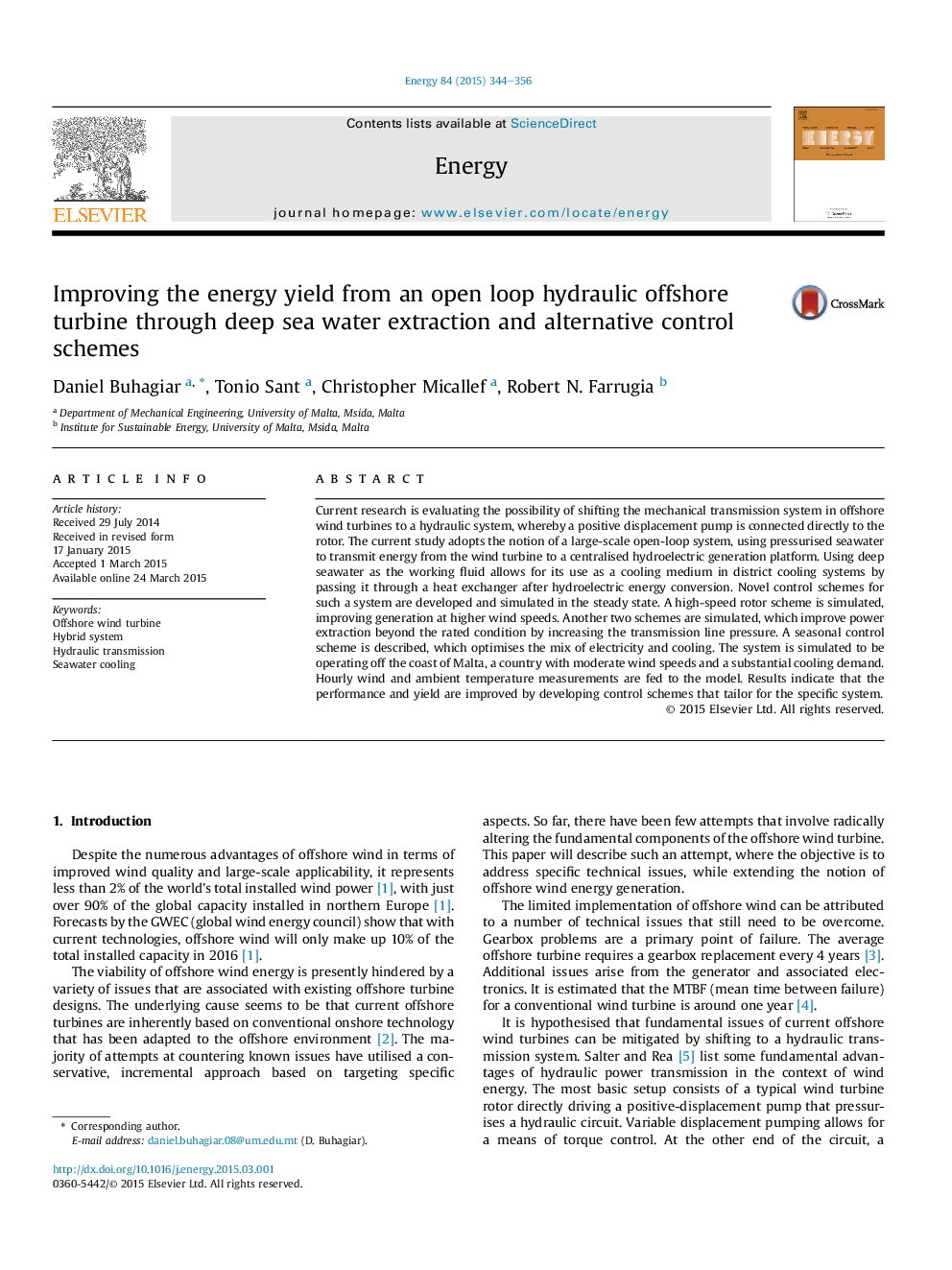| کد مقاله | کد نشریه | سال انتشار | مقاله انگلیسی | نسخه تمام متن |
|---|---|---|---|---|
| 1732314 | 1521462 | 2015 | 13 صفحه PDF | دانلود رایگان |
عنوان انگلیسی مقاله ISI
Improving the energy yield from an open loop hydraulic offshore turbine through deep sea water extraction and alternative control schemes
ترجمه فارسی عنوان
بهبود عملکرد انرژی از یک توربین آزاد دریچه توربین دریایی به وسیله استخراج عمیق آب دریا و طرح های کنترل جایگزین
دانلود مقاله + سفارش ترجمه
دانلود مقاله ISI انگلیسی
رایگان برای ایرانیان
کلمات کلیدی
توربین بادی دریایی، سیستم هیبریدی، انتقال هیدرولیک، خنک کننده دریایی،
ترجمه چکیده
تحقیقات کنونی این است که امکان تغییر سیستم انتقال مکانیکی در توربین های بادی دریایی را به یک سیستم هیدرولیکی ارزیابی می کند، در نتیجه پمپ جابجایی مثبت به طور مستقیم به روتور متصل می شود. در این مطالعه، مفهوم یک سیستم حلقه باز در مقیاس وسیع، با استفاده از آب دریا تحت فشار برای انتقال انرژی از توربین بادی به پلت فرم تولید متمرکز هیدروژن تولید می شود. استفاده از آب عمیق دریا به عنوان مایع کار اجازه می دهد تا برای استفاده از آن به عنوان یک محیط خنک کننده در سیستم های منطقه ای خنک کننده با عبور از طریق مبدل حرارتی پس از تبدیل انرژی هیدروالکتریک. طرح های کنترل رمان برای چنین سیستمی در حالت پایدار شبیه سازی شده است. طرح روتور با سرعت بالا شبیه سازی شده است، بهبود نسل در سرعت های بالاتر باد. دو طرح دیگر نیز شبیه سازی شده اند که با افزایش فشار خط انتقال، باعث افزایش قدرت استخراج بیش از میزان امتیاز می شود. یک طرح کنترل فصلی شرح داده شده است که ترکیب برق و خنک سازی را بهینه می کند. سیستم شبیه سازی شده است که از ساحل مالت، کشوری با سرعت باد متوسط و تقاضای خنک کننده قابل توجهی برخوردار باشد. اندازه گیری ساعت و دمای محیط به صورت ساعت به مدل ارائه می شود. نتایج نشان می دهد که عملکرد و عملکرد با توسعه طرح های کنترل که برای سیستم خاص طراحی شده، بهبود می یابند.
موضوعات مرتبط
مهندسی و علوم پایه
مهندسی انرژی
انرژی (عمومی)
چکیده انگلیسی
Current research is evaluating the possibility of shifting the mechanical transmission system in offshore wind turbines to a hydraulic system, whereby a positive displacement pump is connected directly to the rotor. The current study adopts the notion of a large-scale open-loop system, using pressurised seawater to transmit energy from the wind turbine to a centralised hydroelectric generation platform. Using deep seawater as the working fluid allows for its use as a cooling medium in district cooling systems by passing it through a heat exchanger after hydroelectric energy conversion. Novel control schemes for such a system are developed and simulated in the steady state. A high-speed rotor scheme is simulated, improving generation at higher wind speeds. Another two schemes are simulated, which improve power extraction beyond the rated condition by increasing the transmission line pressure. A seasonal control scheme is described, which optimises the mix of electricity and cooling. The system is simulated to be operating off the coast of Malta, a country with moderate wind speeds and a substantial cooling demand. Hourly wind and ambient temperature measurements are fed to the model. Results indicate that the performance and yield are improved by developing control schemes that tailor for the specific system.
ناشر
Database: Elsevier - ScienceDirect (ساینس دایرکت)
Journal: Energy - Volume 84, 1 May 2015, Pages 344-356
Journal: Energy - Volume 84, 1 May 2015, Pages 344-356
نویسندگان
Daniel Buhagiar, Tonio Sant, Christopher Micallef, Robert N. Farrugia,
